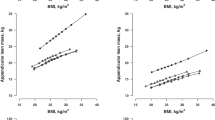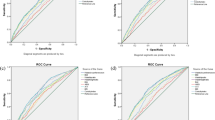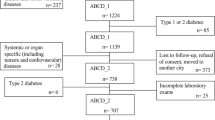Abstract
Background and purpose:
Leptin predicts cardiovascular diseases and type 2 diabetes, diseases to which Asian Indians are highly susceptible. As a risk marker, leptin's intra-individual and seasonal stability is unstudied and only small studies have compared leptin levels in Asian Indians with other populations. The aim of this study was to explore ethnicity related differences in leptin levels and its intra-individual and seasonal stability.
Methods:
Leptin and anthropometric data from the northern Sweden MONICA (3513 Europids) and the Mauritius Non-communicable Disease (2480 Asian Indians and Creoles) studies were used. In both studies men and women, 25- to 74-year old, participated in both an initial population survey and a follow-up after 5–13 years. For the analysis of seasonal leptin variation, a subset of 1780 participants, 30- to 60-year old, in the Västerbotten Intervention Project was used.
Results:
Asian Indian men and women had higher levels of leptin, leptin per body mass index (BMI) unit (leptin/BMI) or per cm in waist circumference (WC; leptin/waist) than Creoles and Europids when adjusted for BMI (all P<0.0005) or WC (all P<0.005). In men, Creoles had higher leptin, leptin/BMI and leptin/waist than Europids when adjusted for BMI or WC (all P<0.0005). In women, Creoles had higher leptin/BMI and leptin/waist than Europids only when adjusted for WC (P<0.0005). Asian Indian ethnicity in both sexes, and Creole ethnicity in men, was independently associated with high leptin levels. The intra-class correlation for leptin was similar (0.6–0.7), independently of sex, ethnicity or follow-up time. No seasonal variation in leptin levels was seen.
Conclusion:
Asian Indians have higher levels of leptin, leptin/BMI and leptin/waist than Creoles and Europids. Leptin has a high intra-individual stability and seasonal leptin variation does not appear to explain the ethnic differences observed here.
This is a preview of subscription content, access via your institution
Access options
Subscribe to this journal
Receive 12 print issues and online access
$259.00 per year
only $21.58 per issue
Buy this article
- Purchase on Springer Link
- Instant access to full article PDF
Prices may be subject to local taxes which are calculated during checkout

Similar content being viewed by others
References
World Health Organization. Obesity: preventing and managing the global epidemic report of a WHO consultation. World Health Organ Tech Rep Ser 2000; 894, i–xii 1–253.
Margetic S, Gazzola C, Pegg GG, Hill RA . Leptin: a review of its peripheral actions and interactions. Int J Obes Relat Metab Disord 2002; 26: 1407–1433.
Hynes GR, Jones PJ . Leptin and its role in lipid metabolism. Curr Opin Lipidol 2001; 12: 321–327.
Beltowski J . Leptin and atherosclerosis. Atherosclerosis 2006; 189: 47–60.
Koh KK, Park SM, Quon MJ . Leptin and cardiovascular disease: response to therapeutic interventions. Circulation 2008; 117: 3238–3249.
Kieffer TJ, Habener JF . The adipoinsular axis: effects of leptin on pancreatic beta-cells. Am J Physiol Endocrinol Metab 2000; 278: E1–E14.
McNeely MJ, Boyko EJ, Weigle DS, Shofer JB, Chessler SD, Leonnetti DL et al. Association between baseline plasma leptin levels and subsequent development of diabetes in Japanese Americans. Diabetes Care 1999; 22: 65–70.
Söderberg S, Zimmet P, Tuomilehto J, Chitson P, Gareeboo H, Alberti KGMM et al. Leptin predicts the development of diabetes in Mauritian men, but not women: a population-based study. Int J Obes 2007; 31: 1126–1133.
Söderberg S, Stegmayr B, Stenlund H, Sjöström LG, Argen A, Johansson L et al. Leptin, but not adoponectin, predicts stroke in males. J Intern Med 2004; 256: 128–136.
Franks PW, Brage S, Luan J, Ekelund U, Rahman M, Farooqi S et al. Leptin predicts a worsening of the features of the metabolic syndrome independently of obesity. Obes Res 2005; 13: 1476–1484.
Qiao Q, Hu G, Tuomilehto J, Nakagami T, Balkau B, Borch-Johnsen K et al. Age- and sex-specific prevalence of diabetes and impaired glucose regulation in 11 Asian cohorts. Diabetes Care 2003; 26: 1770–1780.
International Diabetes Federation. Diabetes Atlas 3rd edition 2006.
Mather HM, Keen H . The Southall Diabetes Survey: prevalence of known diabetes in Asians and Europeans. Br Med J 1985; 291: 1081–1084.
McKeigue PM, Miller GJ, Marmot MG . Coronary heart disease in South Asians overseas: a review. J Clin Epidemiol 1989; 42: 597–609.
Motal AA, Omar MA, Pirie FJ . Epidemiology of type 1 and type 2 diabetes in Africa. J Cardiovasc Risk 2003; 10: 77–83.
Söderberg S, Zimmet P, Tuomilehto J, de Courten M, Dowse GK, Chitson P et al. Increasing prevalence of type 2 diabetes in all ethnic groups in Mauritius. Diabet Med 2005; 22: 61–68.
Abate N, Chandalia M, Snell PG, Grundy SM . Adipose tissue metabolites and insulin resistance in nondiabetic Asian Indian men. J Clin Endocrinol Metab 2004; 89: 2750–2755.
Liew CF, Seah ES, Yeo KP, Lee KO, Wise SD . Lean, nondiabetic Asian Indians have decreased insulin sensitivity and insulin clearance, and raised leptin compared to Caucasians and Chinese subjects. Int J Obes Relat Metab Disord 2003; 27: 784–789.
Ruhl CE, Everhart JE . Leptin concentrations in the United States: relations with demographic and anthropometric measures. Am J Clin Nutr 2001; 3: 295–301.
Ruhl CE, Everhart JE, Ding J, Goodpaster BH, Kanaya AM, Simonsick EM et al. Serum leptin concentrations and body adipose measures in older black and white adults. Am J Clin Nutr 2004; 80: 576–583.
Schutte AE, van Vuuren D, van Rooyen JM, Huisman HW, Schutte R, Malan L et al. Inflammation, obesity and cardiovascular function in African and Caucasian women from South Africa: the PIWIRS study. J Hum Hypertens 2006; 20: 850–859.
Pérez-Bravo F, Albala C, Santos JL, Yañez M, Carrasco E . Leptin levels distribution and ethnic background in two populations fron Chile: Caucasian and Mapuche groups. Int J Obes Relat Metab Disord 1998; 22: 943–948.
Lingärde F, Söderberg S, Olsson T, Ercilla MB, Correa LR, Ahrén B . Overweight is associated with lower serum leptin in Peruvian Indian than in Caucasian women: a dissociation contributing to low blood pressure? Metabolism 2001; 50: 325–329.
Wei M, Stern MP, Haffner SM . Serum leptin levels in Mexican Americans and non-Hispanic whites: association with body mass index and cigarette smoking. Ann Epidemiol 1997; 7: 81–86.
Hergenç G, Schulte H, Assman G, von Eckardstein A . Associations of obesity markers, insulin, and sex hormones with HDL-cholesterol levels in Turkish and German individuals. Atherosclerosis 1999; 145: 147–156.
Tanaka M, Umezaki M, Natsuhara K, Yamauchi T, Inaoka T, Hongo T et al. No difference in serum leptin concentrations between urban-dwelling Austronesians and Non-Austronesians in Papua New Guinea. Am J Hum Biol 2005; 17: 696–703.
Kaplan RC, Ho GY, Xue X, Rajpathak S, Cushman M, Rohan TE et al. Within-individual stability of obesity-related biomarkers among women. Cancer Epidemiol Biomarkers Prev 2007; 16: 1291–1293.
Rousseau K, Atcha Z, Loudon ASI . Leptin and seasonal mammals. J Neuroendocrinol 2003; 15: 409–414.
Donahoo WT, Jensen DR, Shepard TY, Eckel RH . Seasonal variation in lipoprotein lipase and plasma lipids in physically active, normal weight humans. J Clin Endocrinol Metab 2000; 85: 3065–3068.
Plasqui G, Kester AD, Westerterp KR . Seasonal variation in sleeping metabolic rate, thyroid activity, and leptin. Am J Physiol Endocrinol Metab 2003; 285: E338–E343.
Perry III HM, Miller DK, Patrick P, Morley JE . Testosterone and leptin in older African-American men: relationship to age, strength, function and season. Metabolism 2000; 49: 1085–1091.
Stegmayr B, Lundberg V, Asplund K . The events registration and survey procedures in the Northern Sweden MONICA Project. Scand J Public Health Suppl 2003; 61: 9–17.
Central Intelligence Agency (CIA). The World Factbook 2009. CIA: Washington, DC http://www.cia.gov/library/publications/the-world-factbook/geos/mp.html Last accessed: 8th October 2009.
Rolandsson O, Hägg E, Hampe C, Sullivan Jr EP, Nilsson M, Jansson G et al. Glutamate decarboxylase (GAD65) and tyrosine phosphatase-like protein (IA2) autoantibodies index in a regional population is related to glucose intolerance and body mass index. Diabetologia 1999; 42: 555–559.
Reseland JE, Mundal HH, Hollung K, Haugen F, Zahid N, Anderssen SA et al. Cigarette smoking may reduce plasma leptin concentration via catecholamines. Prostaglandins Leukot Essent Fatty Acids 2005; 73: 43–49.
Chandalia M, Lin P, Seenivasan T, Livingston EH, Snell PG, Grundy SM et al. Insulin resistance and body fat distribution in South Asian men compared to Caucasian men. PLoS One 2007; 2: e812.
Maffei M, Halaas J, Ravussin E, Pratley RE, Lee GH, Zhang Y et al. Leptin levels in human and rodent: measurement of plasma leptin and ob RNA in obese and weight-reduced subjects. Nat Med 1995; 1: 1155–1161.
Dua A, Hennes MI, Hoffmann RG, Maas DL, Krakower GR, Sonnenberg GE et al. Leptin: a significant indicator of total body fat but not of visceral fat and insulin insensitivity in African-American women. Diabetes 1996; 45: 1635–1637.
Cnop M, Landchild MJ, Vidal J, Havel PJ, Knowles NG, Carr DR et al. The concurrent accumulation of intra-abdominal and subcutaneous fat explains the association between insulin resistance and plasma leptin concentrations: distinct metabolic effects of two fat compartments. Diabetes 2002; 51: 1005–1015.
Chowdhury B, Lantz H, Sjöström L . Computed tomography-determined body composition in relation to cardiovascular risk factors in Indian and matched Swedish males. Metabolism 1996; 45: 634–644.
WU CH, Heshka S, Wang J, Pierson Jr RN, Heymsfield SB, Laferrère B et al. Truncal fat in relation to total body fat: influences of age, sex, ethnicity and fatness. Int J Obes 2007; 31: 1384–1391.
Banerji MA, Faridi N, Atluri R, Chaiken RL, Lebovitz HE . Body composition, visceral fat, leptin and insulin resistance in Asian Indian men. J Clin Endocrinol Metab 1999; 84: 137–144.
Banerji MA, Lebowitz J, Chaiken RL, Gordon D, Kral JG, Lebovitz HE . Relationship of visceral adipose tissue and glucose disposal is independent of sex in black NIDDM subjects. Am J Physiol 1997; 273: E425–E432.
Couillard C, Mauriège P, Imbeault P, Prud'homme D, Nadeau A, Tremblay A et al. Hyperleptinemia is more closely associated with adipose cell hypertrophy than with adipose tissue hyperplasia. Int J Obes Relat Metab Disord 2000; 24: 782–788.
Lundgren M, Svensson M, Lindmark S, Renström F, Ruge T, Eriksson JW . Fat cell enlargement is an independent marker of insulin resistance and ‘hyperleptinemia’. Diabetologia 2007; 50: 625–633.
Weyer C, Foley JE, Bogardus C, Tataranni PA, Pratley RE . Enlarged subcutaneous abdominal adipocyte size, but not obesity itself, predicts type II diabetes independent of insulin resistance. Diabetologia 2000; 43: 1498–1506.
Weyer C, Wolford JK, Hanson RL, Foley JE, Tataranni PA, Bogardus C et al. Subcutaneous abdominal adipocyte size, a predictor of type 2 diabetes, is linked to chromosome 1q21-q23 and is associated with common polymorphism in LMNA in Pima Indians. Mol Genet Metab 2001; 72: 231–238.
Flier JS . Clinical review 94: what's in a name? In search of leptin's physiologic role. J Clin Endocrinol Metab 1998; 83: 1407–1413.
Al-Delaimy WK, Jansen EH, Peeters PH, van der Laan JD, van Noord PA, Boshuizen HC et al. Replicability of biomarkers of iron status, blood lipids, oxidative stress, vitamin D, C-reactive protein and fructosamine in two Dutch cohorts. Biomarkers 2006; 11: 370–382.
Acknowledgements
We are indebted to the Northern Swedish MONICA Project, the Västerbotten Intervention Program and the Mauritius survey, and the grants supporting them. This study was also supported by grants from the Swedish Heart and Lung foundation, the county councils of northern Sweden (Visare Norr), the Faculty of Medicine, Umeå University. Dr Lilja was supported by the research and development unit of Jämtland county council, Östersund, Sweden and Dr Söderberg was supported by grants from the Swedish Heart and Lung Foundation and the Swedish Society of Medicine. We thank Ray Spark, Karin Hjertqvist and Margareta Danielsson for assistance in technical matters.
Author information
Authors and Affiliations
Corresponding author
Ethics declarations
Competing interests
The authors declare no conflict of interest.
Rights and permissions
About this article
Cite this article
Lilja, M., Rolandsson, O., Shaw, J. et al. Higher leptin levels in Asian Indians than Creoles and Europids: a potential explanation for increased metabolic risk. Int J Obes 34, 878–885 (2010). https://doi.org/10.1038/ijo.2010.19
Received:
Revised:
Accepted:
Published:
Issue Date:
DOI: https://doi.org/10.1038/ijo.2010.19
Keywords
This article is cited by
-
Evidence-Based Consensus on Positioning of SGLT2i in Type 2 Diabetes Mellitus in Indians
Diabetes Therapy (2019)
-
Do gender and ethnic differences in fasting leptin in Indians and Creoles of Mauritius persist beyond differences in adiposity?
International Journal of Obesity (2018)
-
South Asian Cardiovascular Disease & Cancer Risk: Genetics & Pathophysiology
Journal of Community Health (2018)
-
Leptin independently predicts development of sepsis and its outcome
Journal of Inflammation (2017)
-
Obesity in International Migrant Populations
Current Obesity Reports (2017)



